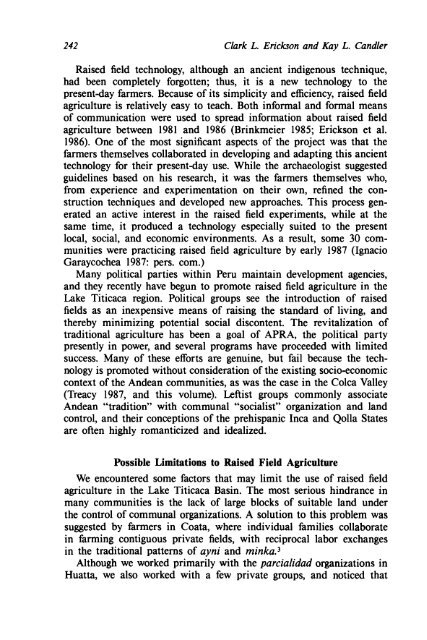Fragile Lands of Latin America Strategies for ... - PART - USAID
Fragile Lands of Latin America Strategies for ... - PART - USAID
Fragile Lands of Latin America Strategies for ... - PART - USAID
You also want an ePaper? Increase the reach of your titles
YUMPU automatically turns print PDFs into web optimized ePapers that Google loves.
242 Clark L. Ericlcron and Kay L. Candler<br />
Raised field technology, although an ancient indigenous technique,<br />
had been completely <strong>for</strong>gotten; thus, it is a new technology to the<br />
present-day farmers. Because <strong>of</strong> its simplicity and efficiency, raised field<br />
agriculture is relatively easy to teach. Both in<strong>for</strong>mal and <strong>for</strong>mal means<br />
<strong>of</strong> communication were used to spread in<strong>for</strong>mation about raised field<br />
agriculture between 1981 and 1986 (Brinkmeier 1985; Erickson et al.<br />
1986). One <strong>of</strong> the most significant aspects <strong>of</strong> the project was that the<br />
farmers themselves collaborated in developing and adapting this ancient<br />
technology <strong>for</strong> their present-day use. While the archaeologist suggested<br />
guidelines based on his research, it was the farmers themselves who,<br />
from experience and experimentation on their own, refined the con-<br />
struction techniques and developed new approaches. This process gen-<br />
erated an active interest in the raised field experiments, while at the<br />
same time, it produced a technology especially suited to the present<br />
local, social, and economic environments. As a result, some 30 com-<br />
munities were practicing raised field agriculture by early 1987 (Ignacio<br />
Garaycochea 1987: pers. com.)<br />
Many political parties within Peru maintain development agencies,<br />
and they recently have begun to promote raised field agriculture in the<br />
Lake Titicaca region. Political groups see the introduction <strong>of</strong> raised<br />
fields as an inexpensive means <strong>of</strong> raising the standard <strong>of</strong> living, and<br />
thereby minimizing potential social discontent. The revitalization <strong>of</strong><br />
traditional agriculture has been a goal <strong>of</strong> APRA, the political party<br />
presently in power, and several programs have proceeded with limited<br />
success. Many <strong>of</strong> these ef<strong>for</strong>ts are genuine, but fail because the tech-<br />
nology is promoted without consideration <strong>of</strong> the existing socio-economic<br />
context <strong>of</strong> the Andean communities, as was the case in the Colca Valley<br />
(Treacy 1987, and this volume). Lefiist groups commonly associate<br />
Andean "tradition" with communal "socialist" organization and land<br />
control, and their conceptions <strong>of</strong> the prehispanic Inca and Qolla States<br />
are <strong>of</strong>ten highly romanticized and idealized.<br />
Possible Limitations to Raised Field Agriculture<br />
We encountered some factors that may limit the use <strong>of</strong> raised field<br />
agriculture in the Lake Titicaca Basin. The most serious hindrance in<br />
many communities is the lack <strong>of</strong> large blocks <strong>of</strong> suitable land under<br />
the control <strong>of</strong> communal organizations. A solution to this problem was<br />
suggested by farmers in Coata, where individual families collaborate<br />
in farming contiguous private fields, with reciprocal labor exchanges<br />
in the traditional patterns <strong>of</strong> ayni and minka.3<br />
Although we worked primarily with the parcialidad organizations in<br />
Huatta, we also worked with a few private groups, and noticed that

















